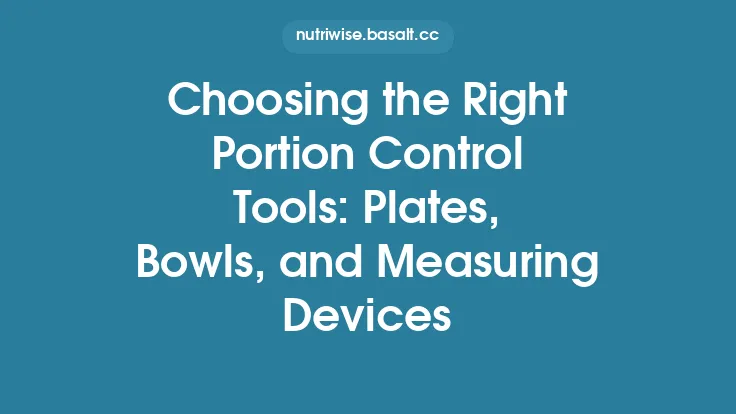Portion control is a buzz‑worthy phrase that appears on everything from diet books to grocery store aisles. Yet, despite its popularity, many of the ideas that surround it are either oversimplified or outright wrong. The good news is that a growing body of nutrition science offers a clearer picture of what “portion control” really means—and, more importantly, what it does not mean. Below we walk through the most common myths, examine the research that challenges them, and distill the evidence into practical, evergreen insights you can rely on for years to come.
Myth 1 — “Portion control means eating less of everything”
Why the myth persists
The phrase “eat less” is often used as a blanket prescription for weight management. It suggests that simply shrinking every bite will automatically lead to better health outcomes.
What the research says
Energy balance is determined by the *difference* between calories consumed and calories expended, not by the absolute size of each bite. A 2015 meta‑analysis of 30 controlled feeding studies found that participants who reduced portion sizes of energy‑dense foods (e.g., cheese, nuts) while maintaining portions of low‑energy foods (e.g., vegetables, broth‑based soups) achieved a net caloric reduction without reporting increased hunger. In contrast, uniformly shrinking all foods often leads to a compensatory increase in intake later in the day, as the body seeks to meet its macronutrient and micronutrient needs.
Takeaway
Effective portion control is selective: reduce portions of foods that are high in energy density while preserving or even modestly increasing portions of nutrient‑dense, low‑calorie foods. This strategy respects the body’s need for essential nutrients while still creating a caloric deficit when that is the goal.
Myth 2 — “All calories are created equal”
Why the myth persists
The classic thermodynamic view of nutrition treats calories as interchangeable units of energy, regardless of their source.
What the research says
While the first law of thermodynamics holds true—energy cannot be created or destroyed—the *biological* impact of calories varies. A 2020 randomized crossover trial compared isocaloric diets differing only in macronutrient composition (high‑protein vs. high‑carbohydrate). Participants on the high‑protein diet reported greater satiety, ate fewer calories ad libitum at a subsequent buffet, and exhibited a modest increase in resting metabolic rate (≈ 5 %). Similar findings have been reported for diets higher in fiber or polyunsaturated fats, which influence gut hormone release (e.g., GLP‑1, PYY) and thus appetite regulation.
Takeaway
When planning portions, consider not just the calorie count but also the macronutrient profile and fiber content. Foods that promote satiety and modestly boost metabolism can help you stay within your target energy range without feeling deprived.
Myth 3 — “Carbohydrates must be eliminated to control portions”
Why the myth persists
Low‑carb and ketogenic diets have popularized the idea that carbs are the primary driver of overeating and weight gain.
What the research says
Carbohydrates are a primary fuel for the brain and central nervous system. A 2018 systematic review of 12 long‑term trials found that moderate carbohydrate intake (45–55 % of total energy) was associated with similar weight outcomes to low‑carb (< 30 %) and high‑carb (> 60 %) patterns when total energy intake was matched. Moreover, complex carbohydrates—especially those high in resistant starch and fiber—slow gastric emptying and blunt post‑prandial glucose spikes, which can reduce subsequent hunger.
Takeaway
Portion control does not require cutting carbs across the board. Focus on the *type* of carbohydrate: prioritize whole grains, legumes, fruits, and vegetables that are high in fiber and have a lower glycemic impact.
Myth 4 — “Eating more frequently prevents overeating”
Why the myth persists
The “small, frequent meals” mantra suggests that spreading calories across the day keeps blood sugar stable and curbs cravings.
What the research says
Evidence is mixed. A 2017 meta‑analysis of 16 feeding studies found no consistent advantage of 5–6 small meals per day over 3 larger meals in terms of total energy intake or body weight. In fact, some participants reported higher overall caloric intake when meals were fragmented, likely due to reduced satiety signals between eating occasions. The key driver appears to be *total* energy density and macronutrient composition, not meal frequency per se.
Takeaway
Choose a meal pattern that fits your lifestyle and hunger cues. Whether you eat three meals or five, ensure each eating occasion includes a balance of protein, fiber, and healthy fats to promote satiety.
Myth 5 — “Low‑fat or “diet” foods automatically reduce portion size”
Why the myth persists
Food manufacturers label products as “low‑fat,” “diet,” or “light,” implying they are automatically healthier and can be consumed in larger amounts.
What the research says
Many low‑fat products compensate for reduced fat with added sugars, refined starches, or artificial sweeteners, which can increase palatability and lead to overconsumption. A 2016 double‑blind study showed that participants ate 30 % more of a low‑fat yogurt compared with its full‑fat counterpart, despite identical protein and carbohydrate content. The overall caloric intake was therefore similar, negating the intended benefit.
Takeaway
Do not assume that “low‑fat” equals “lower calories.” Evaluate the full nutrition profile—especially added sugars and total carbohydrate content—when deciding portion size.
Myth 6 — “Your body will self‑regulate portion size without guidance”
Why the myth persists
The notion that the body’s internal hunger and fullness signals are sufficient to keep intake in check is appealingly simple.
What the research says
While homeostatic mechanisms (e.g., leptin, ghrelin) play a role, they are heavily influenced by external cues such as food environment, portion size, and sensory properties. A landmark 2007 study demonstrated that participants served themselves 2–3 times more food when presented with larger plates, even though they reported similar fullness after eating. Moreover, chronic exposure to oversized portions can shift the “set point” of perceived normal portion size, leading to gradual weight gain.
Takeaway
External cues matter. Being aware of the visual and environmental factors that influence how much you serve yourself is a critical component of effective portion control.
Myth 7 — “Portion control is only relevant for weight loss”
Why the myth persists
Many resources frame portion control as a weight‑loss tool, overlooking its broader health implications.
What the research says
Portion size influences nutrient density, glycemic control, and cardiovascular risk independent of weight change. A 2019 prospective cohort of 12,000 adults found that individuals who consistently consumed smaller portions of processed meats and sugary beverages had a 15 % lower incidence of hypertension, even after adjusting for body mass index. Similarly, portion control of sodium‑rich foods can directly affect blood pressure.
Takeaway
Portion control supports overall health—blood pressure, lipid profiles, and glycemic stability—regardless of whether weight loss is a goal.
Myth 8 — “One‑size‑fits‑all portion recommendations work for everyone”
Why the myth persists
Guidelines that list a single “standard” serving (e.g., 1 cup of cooked rice) are easy to communicate and remember.
What the research says
Individual variability in basal metabolic rate, body composition, and hormonal milieu means that a universal portion size cannot meet everyone’s needs. A 2021 cross‑sectional analysis of 5,000 adults showed that the same 1‑cup rice portion contributed anywhere from 10 % to 30 % of daily energy needs, depending on age, sex, and activity level. Moreover, genetic differences in taste receptors and satiety hormone sensitivity can alter how much a person feels satisfied after a given portion.
Takeaway
Use standard portion references as *starting points*, not absolutes. Adjust based on personal energy requirements, hunger signals, and health goals.
Myth 9 — “Snacking is inherently a failure of portion control”
Why the myth persists
Snacking is often portrayed as a loophole that undermines disciplined eating patterns.
What the research says
When chosen wisely, snacks can improve overall diet quality and help regulate appetite. A 2018 randomized trial compared two groups: one that ate three main meals only, and another that added two nutrient‑dense snacks (e.g., Greek yogurt with berries). The snack group reported lower overall hunger, ate fewer calories at dinner, and maintained a healthier macronutrient distribution. The key is *what and how much* is consumed, not the act of snacking itself.
Takeaway
Incorporate planned, portion‑controlled snacks that contain protein and fiber to bridge long gaps between meals and prevent overeating later.
Myth 10 — “Technology (apps, trackers) replaces the need for understanding portions”
Why the myth persists
The proliferation of calorie‑counting apps gives the impression that data entry alone can manage intake.
What the research says
While digital tools can improve awareness, they are only as accurate as the user’s input. A 2022 validation study found that self‑reported portion sizes in popular apps were off by an average of 25 % compared with weighed portions. Moreover, reliance on numbers can distract from physiological cues and lead to obsessive tracking behaviors.
Takeaway
Use technology as a *supplement* to, not a substitute for, a solid grasp of portion concepts—energy density, macronutrient balance, and satiety factors.
What the research consistently shows
- Energy density matters more than sheer calorie counting. Foods low in energy density (high water and fiber) allow larger volumes for fewer calories, supporting satiety without excess intake.
- Macronutrient composition influences hunger hormones. Protein and soluble fiber stimulate peptide YY and GLP‑1, reducing subsequent food intake.
- External cues—plate size, packaging, and environment—shape how much we serve ourselves. Managing these cues can be as effective as any diet plan.
- Individual variability is the norm. Age, sex, body composition, and metabolic health dictate how many calories a given portion provides relative to personal needs.
- Portion control is a health tool, not just a weight‑loss trick. It impacts blood pressure, lipid profiles, and glycemic control independent of body weight.
Practical, research‑backed guidelines for lifelong portion control
- Prioritize volume‑rich, low‑energy foods (vegetables, broth‑based soups, fruits) to fill the plate while keeping calories modest.
- Include a protein source and a fiber source at every main eating occasion to trigger satiety hormones and slow gastric emptying.
- Mind the “plate effect.” Use smaller dinnerware or pre‑portion foods into containers before sitting down; this reduces the unconscious tendency to overfill the plate.
- Adjust portions based on personal energy needs rather than default serving sizes. A simple method is to calculate basal metabolic rate (BMR) and add a modest activity factor; then allocate calories across meals proportionally.
- Plan structured snacks that are ≤ 150 kcal, contain ≥ 10 g protein, and ≥ 3 g fiber. Examples: a handful of almonds with an apple slice, or cottage cheese with cucumber.
- Read nutrition labels critically. Look beyond “low‑fat” or “diet” claims; assess total calories, added sugars, and fiber.
- Periodically reassess portion sizes. As weight, activity level, or health status changes, so should the amount you serve yourself.
- Use technology as a check, not a crutch. Log meals occasionally to spot patterns, but rely on visual and tactile cues (e.g., the “fist” for vegetables, the “palm” for protein) for day‑to‑day decisions.
By grounding your approach in these evidence‑based principles, you can cut through the noise of popular myths and adopt a portion‑control strategy that supports both short‑term goals and long‑term health. The science tells us that it’s not about eating less of everything, but about eating smarter—choosing the right foods, in the right amounts, and being aware of the environmental cues that shape our choices. Armed with that knowledge, you’re ready to make portion control a sustainable, health‑promoting habit.





